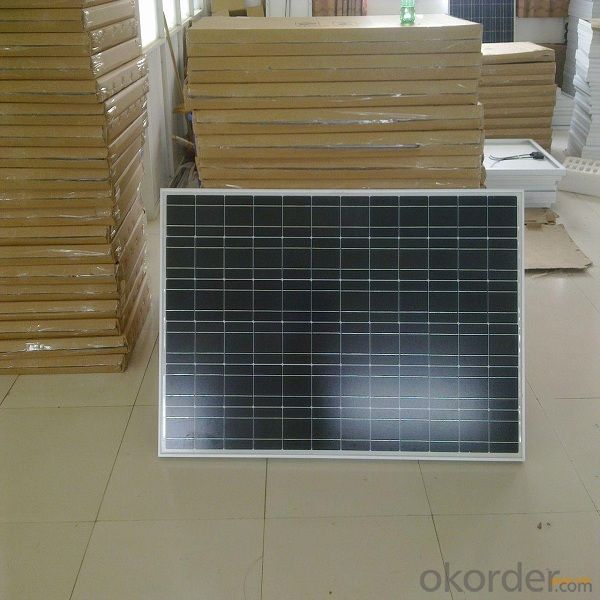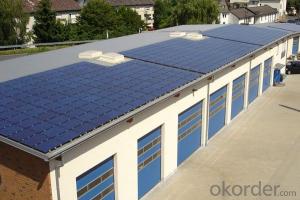High Power 230W/30V Poly Solar Panel for Sale
- Loading Port:
- Tianjin
- Payment Terms:
- TT OR LC
- Min Order Qty:
- 100 watt
- Supply Capability:
- 10000 watt/month
OKorder Service Pledge
OKorder Financial Service
You Might Also Like
Item specifice

Quality Ensurance:
1. Excellent backsheet from SFC, 3M;
2. Junction box with UL and TUV listed - GZX, IP65;
3. High transmission low iron tempered glass from Xinyi Glass - China Top 1;
4. Solar panels with TUV, CE, ISO9001 certified.
Under Standard Test Conditions(STC): Irradiance of 1000W/m2, Am1.5 and 25º C cell temperature
Operating Temperature: -40 ~ +85° C
Storage Temperature: -40 ~ +85° C
Mechanical Characteristics:
Dimensions: 1665mm(L) x 991mm(W) x 50mm(H)
Weight: 19.8KG
Polycrystalline 156*156 solar cells: 60 cells
Module Warranty:
Warranty on material and workmanship: 5 years
Guaranteed output of 90% after 10 years and 80% after 25 years.
| Performance | ||
| Rated Power[Pmax] | 230W | |
| Power Tolerance | ± 3% | |
| Nominal Voltage | 30V | |
| Design Life | 25 years | |
| Electrical Characteristics | ||
| Maximum Power [Pmax] | 230W± 3% | |
| Maximum Power Voltage [Vmp] | 30.29V± 3% | |
| Maximum Power Current [Imp] | 7.59A± 3% | |
| Short-Circuit Current [Isc] | 8.19A± 3% | |
| Open-Circuit Voltage [Voc] | 36.53V± 3% | |
| Current Temperature Coefficient | 0.08%/º C | |
| Voltage Temperature Coefficient | - 0.32%/º C | |
| Power Temperature Coefficient | -0.38%/º C | |
| Maximum System Voltage | 1000V | |
- Q:I am looking to wire in some solar panels into my home. I already have plenty of wiring, and some solar panels around. I just need to know what I need to do to wire them into my home so I can lower my electric bill. This past month it was six hundred dollars.Can someone direct me to some information, or tell me how without telling me to hire some guy to come out to charge me thirty thousand dollars to install two or three thousand dollars worth of equipment?
- I okorder Hope this helps.
- Q:can solar panels be on houses? malls?stores? WHAT ABOUT TRAINS?
- Solar panel is an alternative source of energy. Solar panels are like plants, they take energy from sunlight. Only in solar panels, electricity is produced instead of oxygen. This electricity is used to power homes just like cable electricity.
- Q:Can solar panels be installed on a gas station or convenience store?
- Yes, solar panels can be installed on a gas station or convenience store. In fact, many gas stations and convenience stores have successfully integrated solar panels into their infrastructure to generate renewable energy and reduce their reliance on traditional energy sources.
- Q:Can solar panels be used for charging batteries?
- Yes, solar panels can be used for charging batteries. Solar panels convert sunlight into electricity, which can be used to charge batteries and store energy for later use. This process is commonly used in off-grid systems or to power portable devices and vehicles.
- Q:Can solar panels be installed in areas prone to hurricanes or tornadoes?
- Yes, solar panels can be installed in areas prone to hurricanes or tornadoes. However, additional precautions and engineering considerations need to be taken to ensure their durability and resistance against strong winds and potential impact from debris. This can include using reinforced mounting systems, implementing proper anchoring techniques, and selecting panels that meet stringent wind load requirements.
- Q:Can solar panels be damaged by hail or other elements?
- Yes, solar panels can be damaged by hail or other elements. Hailstones can cause cracks or dents in the panels, impairing their functionality. Other elements like heavy rain, strong winds, or debris from storms can also potentially damage solar panels. However, most solar panels are designed to withstand typical weather conditions and are often tested for durability.
- Q:I don't know anything about solar and what connections that have to be made. any advice and wisdom would be appreciated. thanks
- Yes. Basically, here's what you need (I'm keeping this general on purpose): The panels themselves -- how large an area depends on average power consumption and how much power you can get on average. That, in turn , depends on climate. You'd need more in Seattle than Tuscon, for example. I'd guess something in the neighborhod of 0 square feet. Depends also on haow many gadgets (printers, etc.) you have. You'll need a power storage system. Lithium gives you the best poser density (of off-the-shelf stuff) but an ordinary car battery works well and is reliable. And, of course, a control system to manage the power generation/storage/use so everything works together without that annoying smell that tells you you just cooked a few hundred bucks worth of equuipment! :)
- Q:Ok, so my homework was to research and write about how solar panels and solar furnaces work and about their construction. We didn't even take one lesson on it in class and we are not allowed to copy and paste much and have to keep it simple wtf? Its soo annoying as we have hardly took it in class. Please can someone help.
- Well solar panels conduct electricity from the suns waves and turns it into dc current then it is either put into a grid tie inverter to change it to AC and it makes you meter go backwards instead of forwards. or if its not a grid tie inverter it is just put into batteries as dc then changed into AC from the inverter and then used for household appliances. nothing really does run on DC that is why it has to be changed. and for solar furnaces if you mean a water heater that works by a substance here in Pa its antifreeze is heated up by the sun in the panel it is in a continous loop and that is what gets heated up the water then flows over tow of the tube that contains what ever substance such as antifreeze and heats the water.were the water and the tube that changes the water from cold to hot is called the heat exchanger. the substance is actually get heated first then the water. solar heating for water accounts for 29% of water heating in the us. Now if you mean solar furnace as in passive solar thats completely different because here in Pa if we want it our houses have to face to south to get the suns rays. (alot more windows) and there is a cement slab placed only on the south side of the house and it has insulation covering it. There is a certain type of glass that is used for this that will allow the suns rays to come in and let the heat in for the summer and also for the winter. the main place for that would mostly be the first floor of the house due to the height of the windows and the angle of the sun(pa in the summer is 73 degrees and in the winter its 27 degrees) thats when the second floor would be ok to heat the rooms. Hopefully i helped and i explained it in a way that you can understand.
- Q:i've heard environmentalists like ed begley jr use the phrase quot;peak shaving hourswhen talking about solar energy.what does that phrase mean, please?thank you to all who respond.
- Graminoids are among the most versatile life forms. They became widespread toward the end of the Cretaceous period, and fossilized dinosaur dung (coprolites) have been found containing phytoliths of a variety that include grasses that are related to modern rice and bamboo. Grasses have adapted to conditions in lush rain forests, dry deserts, cold mountains and even intertidal habitats, and are now the most widespread plant type; grass is a valuable source of food and energy for all sorts of wildlife and organics. Graminoids are the dominant vegetation in many habitats, including grassland, salt-marsh, reedswamp and steppes. They also occur as a smaller part of the vegetation in almost every other terrestrial habitat. There are some 3,500 species of graminoids. Many types of animals eat grass as their main source of food, and are called graminivores – these include cattle, sheep, horses, rabbits and many invertebrates, such as grasshoppers and the caterpillars of many brown butterflies. Grasses are also eaten by omnivorous or even occasionally by primarily carnivorous animals. In the study of ecological communities, herbaceous plants are divided into graminoids and forbs, which are herbaceous dicotyledons, mostly with broad leaves.
1. Manufacturer Overview |
|
|---|---|
| Location | |
| Year Established | |
| Annual Output Value | |
| Main Markets | |
| Company Certifications | |
2. Manufacturer Certificates |
|
|---|---|
| a) Certification Name | |
| Range | |
| Reference | |
| Validity Period | |
3. Manufacturer Capability |
|
|---|---|
| a)Trade Capacity | |
| Nearest Port | |
| Export Percentage | |
| No.of Employees in Trade Department | |
| Language Spoken: | |
| b)Factory Information | |
| Factory Size: | |
| No. of Production Lines | |
| Contract Manufacturing | |
| Product Price Range | |
Send your message to us
High Power 230W/30V Poly Solar Panel for Sale
- Loading Port:
- Tianjin
- Payment Terms:
- TT OR LC
- Min Order Qty:
- 100 watt
- Supply Capability:
- 10000 watt/month
OKorder Service Pledge
OKorder Financial Service
Similar products
New products
Hot products
Related keywords





























